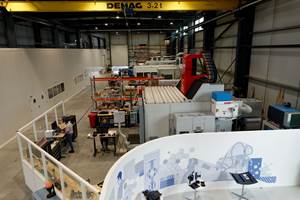How EPA's eight-hour ozone emission regulations may affect composites manufacturers
Susan Bassett is a chemical engineer and air quality consultant. As president of Cogent Regulatory Science Inc. (Centennial, Colo., U.S.A.), she helps composite parts manufacturers understand and comply with air quality regulations. A Tale Of Two Maps Location, location, location is the leading factor in determining
A Tale Of Two Maps
Location, location, location is the leading factor in determining whether your composite parts manufacturing facility may face new emission limits. On April 30, 2004, the U.S. Environmental Protection Agency (EPA) finalized nonattainment area designations (69 Federal Register 23857) under its eight-hour ground-level ozone standard. These designations indicate whether your facility faces more or less regulation of volatile organic compounds (VOCs) under the National Ambient Air Quality Standards (NAAQS) program (for background 24 on the eight-hour ozone standard, see "Composites & Compliance," CT February 2004, p. 8).
The accompanying U.S. maps illustrate the regulatory changes. The first map shows counties currently designated as nonattainment areas under EPA's one-hour, 0.12-ppm ozone standard, which dates back to . The second map shows counties designated nonattainment under the newer eight-hour, 0.08-ppm ozone standard. While some areas of the United States look much the same from one map to another, big differences are seen in other parts of the nation. More than twice as many counties are nonattainment under the eight-hour standard, compared to the older one-hour standard.
For example, new nonattainment areas are pervasive in the eastern half of the United States. Nine states that currently meet the one-hour ozone standard throughout their jurisdictions will see multiple counties designated nonattainment. Other eastern states with existing nonattainment areas will see substantially wider swaths of their states become nonattainment. North Carolina, South Carolina, Tennessee, Michigan, Ohio and Indiana (all home to many composites facilities) are particularly hard hit by the new designations.
The impact that eight-hour ozone nonattainment designations will have depends on how individual areas are classified and how states decide to cut VOC emissions. With the exception of southern California, states need to implement emission cuts in time to meet the 0.08-ppm ozone standard between June 2007 and June 2010, unless they receive EPA approval to extend the deadlines. In areas designated nonattainment, building new facilities and expanding existing facilities becomes more difficult for facilities that are major sources of VOCs. The major-source threshold also ratchets down from 100 tons per year (tpy) of VOCs in attainment areas to as little as 25 tpy in severe ozone nonattainment areas.
For nonattainment areas, state air quality agencies will estimate the quantity of emission reductions needed to meet the 0.08-ppm ozone standard. States will scrutinize VOC and nitrogen oxides (NOx) emissions (which react with VOCs to create ozone).
After determining needed emission reductions, state agencies will estimate expected VOC and NOx reductions from air regulations that are already on the books, but may not yet be implemented. For example, several Maximum Achievable Control Technology (MACT) rules mandating VOC reductions have compliance deadlines in the 2004 to 2007 timeframe (including the reinforced plastic composites MACT). Other air quality rules reduce NOx emissions from electric utilities and other facilities throughout the eastern U.S.
EPA's regulations require that all ozone nonattainment areas classified as moderate, serious or severe operate vehicle inspection and monitoring programs. If nonattainment areas do not already implement vehicle monitoring programs, these emission cuts also can be considered toward the emission reduction goal.
Finally, state agencies will determine the size of the gap between the emission reduction goal and expected emission reductions from existing regulations. State or local air quality agencies will then review industry emissions to identify additional emission restrictions.
As far as composite parts manufacturers are concerned, there is good news and bad news. The good news is that non-composites MACT standards can go a long way toward meeting needed VOC emission reductions. The bad news is that, due to relatively small VOC emission reductions (on a percentage basis) included in the composites MACT, composites facilities could be targeted for additional emission restrictions in some nonattainment areas.
Finally, the old one-hour ozone standard will go the way of the dinosaurs. The 0.12-ppm standard becomes obsolete on June 15, 2005. This means that state agencies and facilities will not be required to meet two separate ozone standards simultaneously.
Related Content
JEC World 2023 highlights: Recyclable resins, renewable energy solutions, award-winning automotive
CW technical editor Hannah Mason recaps some of the technology on display at JEC World, including natural, bio-based or recyclable materials solutions, innovative automotive and renewable energy components and more.
Read MoreNovel composite technology replaces welded joints in tubular structures
The Tree Composites TC-joint replaces traditional welding in jacket foundations for offshore wind turbine generator applications, advancing the world’s quest for fast, sustainable energy deployment.
Read MorePlant tour: Daher Shap’in TechCenter and composites production plant, Saint-Aignan-de-Grandlieu, France
Co-located R&D and production advance OOA thermosets, thermoplastics, welding, recycling and digital technologies for faster processing and certification of lighter, more sustainable composites.
Read MoreNatural fiber composites: Growing to fit sustainability needs
Led by global and industry-wide sustainability goals, commercial interest in flax and hemp fiber-reinforced composites grows into higher-performance, higher-volume applications.
Read MoreRead Next
Developing bonded composite repair for ships, offshore units
Bureau Veritas and industry partners issue guidelines and pave the way for certification via StrengthBond Offshore project.
Read More“Structured air” TPS safeguards composite structures
Powered by an 85% air/15% pure polyimide aerogel, Blueshift’s novel material system protects structures during transient thermal events from -200°C to beyond 2400°C for rockets, battery boxes and more.
Read MoreAll-recycled, needle-punched nonwoven CFRP slashes carbon footprint of Formula 2 seat
Dallara and Tenowo collaborate to produce a race-ready Formula 2 seat using recycled carbon fiber, reducing CO2 emissions by 97.5% compared to virgin materials.
Read More












.jpg;maxWidth=300;quality=90)











